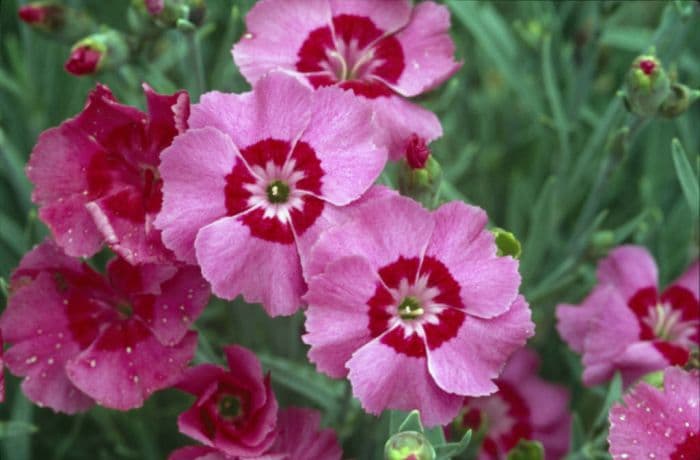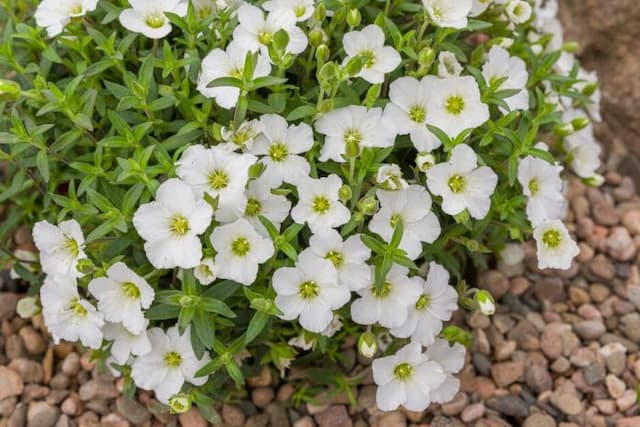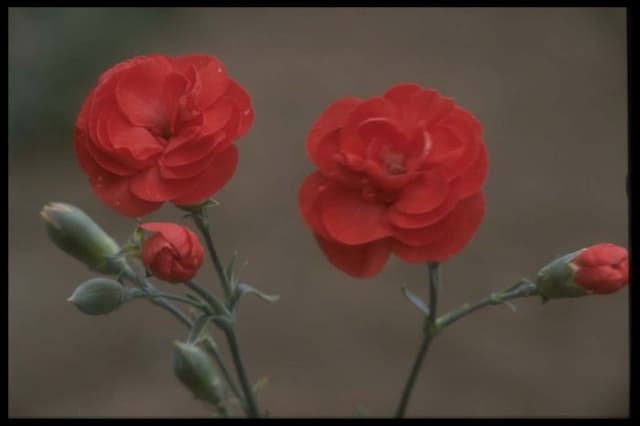Sweet William Dianthus 'Pixie Star' (PBR) (p)

ABOUT
Dianthus 'Pixie Star' is a charming cultivated variety that stands out with its beautifully patterned flowers. The petals are typically a delightful shade of pink, sporting a conspicuous central eye that is often a deeper or contrasting hue, adding depth and character to each bloom. The flowers display a frilled or toothed edge, which contributes to their intricate and dainty appearance. This ornamental gem forms a dense, mounded clump of slender, linear leaves that are a bluish-green color, providing a cool and elegant backdrop for the striking, colorful blooms that rise above the foliage on slender stems. The plant exudes a pleasant fragrance, which is most noticeable when basking in the warmth of the sun. The overall impression is one that exudes a cottage garden charm, inviting onlookers to take a moment to enjoy its sweet scent and delightfully intricate blooms.
About this plant
 Names
NamesFamily
Caryophyllaceae.
Synonyms
Cheddar Pinks, Pinks, Sweet William.
Common names
Dianthus 'Pixie Star' (PBR) (p)
 Toxicity
ToxicityTo humans
Dianthus 'Pixie Star', commonly known as Dianthus, is not typically known to be poisonous to humans. Most Dianthus species are considered non-toxic and are often used in gardens for their colorful flowers without concern for human health. However, consumption of any plant material can potentially cause gastrointestinal discomfort, so it is always advised to refrain from eating any part of ornamental plants unless they are explicitly edible.
To pets
Dianthus 'Pixie Star', commonly referred to as Dianthus, is also generally considered to be non-toxic to pets. While these plants are not associated with serious poisoning in animals, ingestion of plant parts might result in mild gastrointestinal upset such as vomiting or diarrhea in sensitive individuals. As with humans, it is best to prevent pets from ingesting plants that are not intended for consumption.
 Characteristics
CharacteristicsLife cycle
Perennials
Foliage type
Evergreen
Color of leaves
Blue-green
Flower color
Pink
Height
6 inches (15 cm)
Spread
8 inches (20 cm)
Plant type
Herb
Hardiness zones
7
Native area
Europe
Benefits
 General Benefits
General Benefits- Easy to grow: Dianthus 'Pixie Star' is known for being easy to cultivate, making it ideal for gardeners of all skill levels.
- Attractive flowers: The plant produces vibrant, colorful blossoms that can enhance the visual appeal of any garden or floral arrangement.
- Long blooming period: It typically has a longer flowering season compared to many other plants, providing color for an extended period.
- Pleasant fragrance: Dianthus species are known for their sweet, spicy scent that can add a delightful fragrance to your garden or home when used as cut flowers.
- Drought tolerance: Once established, Dianthus 'Pixie Star' can tolerate periods of dryness, requiring less water than many other garden plants.
- Compact size: Its petite form makes it suitable for small gardens, rockeries, borders, or container gardening.
- Attracts pollinators: The blooms can attract bees and butterflies, promoting pollination and supporting local biodiversity.
- Low maintenance: This plant generally requires minimal pruning and care, making it a good option for those who want a beautiful garden without a lot of work.
- Cold hardy: Dianthus 'Pixie Star' can withstand cooler temperatures, which makes it suitable for a variety of climates.
 Medical Properties
Medical PropertiesThis plant is not used for medical purposes.
 Air-purifying Qualities
Air-purifying QualitiesThis plant is not specifically known for air purifying qualities.
 Other Uses
Other Uses- Culinary Garnish: The petals of the Dianthus 'Pixie Star' are edible and can be used to add a splash of color and subtle spicy flavor to salads, desserts, and drinks.
- Homemade Potpourri: Dried petals of this plant can be combined with other dried flowers and spices to create a fragrant potpourri.
- Bookmarks: Press the flowers between the pages of a heavy book, allowing them to dry flat, and then use them as delicate bookmarks.
- Natural Dye: The flowers can be used to create a natural dye for fabrics, imparting shades of pink or light red depending on the mordant used.
- Flower Confetti: Petals can be scattered as biodegradable confetti for weddings or other celebrations, offering an eco-friendly alternative to synthetic confetti.
- Craft Projects: The flowers and foliage can be used in scrapbooking, greeting card making, or to enhance other paper crafts.
- Bath Infusions: Fresh or dried petals can be added to bathwater for a fragrant, relaxing soak.
- Photography Subjects: The unique pattern of the 'Pixie Star' makes it an interesting subject for photography, giving an aesthetic appeal to photo projects or flower portraits.
- Table Setting Decorations: Fresh flowers can be placed in small vases or laid directly on tables to create natural, charming tablescapes for events.
- Artistic Inspiration: The intricate patterns on the flowers can inspire designs in various forms of art, including textiles, paintings, and digital art.
Interesting Facts
 Feng Shui
Feng ShuiThe Dianthus or Carnation can be used in Feng Shui for inviting positive energy associated with love and healing into a home or garden space. They might be placed in the Love & Marriage area of the Bagua map to enhance romantic relationships or in the Health area to support well-being.
 Zodiac Sign Compitability
Zodiac Sign CompitabilityThe Carnation is not used in astrology practice.
 Plant Symbolism
Plant Symbolism- Love: The common name for Dianthus is "Carnation," which is often associated with love and affection, making it a popular choice for romantic occasions.
- Fascination: Carnations can symbolize a captivated feeling or fascination with another person, often given to express a sense of bewitchment.
- Distinction: The unique patterns and markings on the Dianthus 'Pixie Star' suggest distinctiveness and individuality.
- Devotion: Carnations are a traditional symbol of devotion and commitment between partners, friends, or family members.
- Admiration: Lighter shades of carnations, similar to the ones 'Pixie Star' may exhibit, often express admiration and the message "I find you fascinating."
 Water
WaterPixie Stargrass should be watered deeply once the top inch of the soil feels dry to the touch, usually this can be every week or more depending on the weather conditions. It's important to avoid overwatering, as these plants are drought-tolerant and prefer well-drained soil. During the active growing season, which is generally in spring and summer, you may need to water more frequently. A good rule of thumb is to provide Pixie Stargrass with approximately one gallon of water per plant every week during hot and dry periods.
 Light
LightPixie Stargrass thrives best in full sun, which means at least six hours of direct sunlight daily. The ideal spot for this plant would be in a location where it can receive unfiltered sunlight for most of the day. Adequate sunlight is crucial for the plant to develop its vibrant colors and to bloom profusely.
 Temperature
TemperaturePixie Stargrass prefers temperate climates and can generally withstand temperatures ranging from just above freezing to about 85 degrees Fahrenheit. They can survive short periods of colder temperatures down to about 20 degrees Fahrenheit but consistently cold temperatures below this range can damage or kill the plant. The ideal temperature range for Pixie Stargrass is between 60 to 75 degrees Fahrenheit.
 Pruning
PruningPixie Stargrass benefits from regular pruning to remove dead or yellowing leaves and spent blooms to encourage further flowering and maintain the plant’s compact shape. Pruning should be done after the main flowering season, typically in the late summer or early fall. It's generally recommended to prune these plants back by one-third to promote healthy new growth.
 Cleaning
CleaningAs needed
 Soil
SoilThe best soil mix for the Pinks (Common name for Dianthus) is well-draining and loose, with added compost or well-rotted manure to enrich. A preferred soil pH for 'Pixie Star' is slightly alkaline, around 7.0-7.5.
 Repotting
RepottingPinks should be repotted every two to three years or when you notice the soil has degraded or the plant is outgrowing its pot.
 Humidity & Misting
Humidity & MistingPinks thrive in average humidity conditions. They prefer drier air over highly humid environments, so aim for a relative humidity level around 40-60%.
 Suitable locations
Suitable locationsIndoor
Place in bright light, well-draining soil, and water sparingly.
Outdoor
Full sun, well-draining soil, protect from severe winter wet.
Hardiness zone
7-9 USDA
 Life cycle
Life cycleDianthus 'Pixie Star', commonly known as Pinks, begins its life cycle with seed germination, requiring well-drained soil and full sun for optimal growth. Once the seeds sprout, the next stage is the formation of a small rosette of leaves close to the ground. As the plant matures, it develops sturdy stems that give rise to its distinctive flowers, often in shades of pink with a sweet fragrance. After blooming, which typically occurs in late spring to early summer, the plant sets seeds that are dispersed for the next generation. Pinks are perennial, meaning they can survive for several years in the garden, dying back in autumn and winter to re-emerge and repeat their life cycle in the spring. Proper care during the growth phase, including deadheading to encourage additional blooming and division every few years to maintain vigor, is essential for the longevity and health of the plant.
 Propogation
PropogationPropogation time
Spring-Early Summer
Dianthus 'Pixie Star', commonly known as Pink 'Pixie Star', can be propagated most successfully through softwood cuttings in late spring. To achieve this, a gardener should select a healthy, non-flowering stem and cut a piece about 4-6 inches (10-15 cm) in length, just below a node. The lower leaves are removed, and the cut end can be dipped in rooting hormone to encourage root growth. Next, the cutting is planted in a well-draining soil mix, with the cut end buried about an inch deep. The environment should be kept humid, for instance by covering with a plastic bag or using a propagation dome, and the soil should remain moist but not waterlogged. Warmth is important, so providing bottom heat can be beneficial. Roots should begin to develop within a few weeks, after which the new plants can be gradually acclimated to less humid conditions and eventually planted out into the garden.


![Pink [Tequila Sunrise]](/_next/image?url=https%3A%2F%2Fplants-admin.emdemapps.com%2Fimages%2Fplants%2F%2Fimages%2F604b5d995d06e.png&w=640&q=75)






